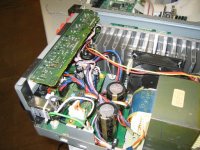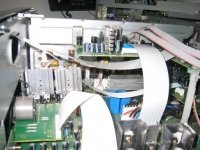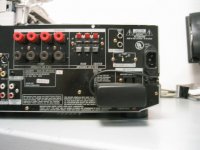I came across a Sony STR-DE945 home theater receiver for practically nothing, and I decided to start experimenting with it. The home theater performance was adequate, but it severely lacked in the music department. I took it upon myself to remedy that.
First I added a cooling fan (powered by its own power supply) to the large heatsink. The receiver would get overly hot at times, a sign of a weak power supply. Then I removed the original power cord and added an EMI filtered IEC plug to the back. I also added two more banks of capacitors to the main amp power supply (now has a total of 6x 10,000uFd/80volt capacitors). I also added heatsinks to various power regulators and other ICs that seemed to get inordinately hot. And as of yesterday, I added an LED to the volume knob powered by a 5-volt source within the amp. Everything I have done (accept for the addition of the LED) has added, I believe, to the musical performance of the amplifier.
Now for the fun part. I have two identical transformers from two other amps (identical to each other, not to the Sony, although they are only a few volts off). I am thinking of increasing the current available to the amplifier by creating two more power supply sections from these transformers and adding them in parallel to the current setup. In theory this should almost triple the available current without messing with the voltage (too badly), and therefore running the output transistors horribly out of spec. The additional two power supplies would be mounted in an external enclosure with a cable running between the receiver and the “supercharger”. This would also give me the ability to use the receiver without the additional power supplies when or if needed.
Now here is the question: While everything works in theory, will I end up with a small explosion for all my troubles? I am planning on converging the power after the rectifier circuit (each transformer will have its own rectifier and filter banks), more or less like running several batteries in parallel. So that would be three transformers and three rectifier circuits.
For those who think me mad for putting all this time and effort in to supercharging a Best Buy Tax Return Special Receiver™, I can only say I have the parts and the time.

First I added a cooling fan (powered by its own power supply) to the large heatsink. The receiver would get overly hot at times, a sign of a weak power supply. Then I removed the original power cord and added an EMI filtered IEC plug to the back. I also added two more banks of capacitors to the main amp power supply (now has a total of 6x 10,000uFd/80volt capacitors). I also added heatsinks to various power regulators and other ICs that seemed to get inordinately hot. And as of yesterday, I added an LED to the volume knob powered by a 5-volt source within the amp. Everything I have done (accept for the addition of the LED) has added, I believe, to the musical performance of the amplifier.
Now for the fun part. I have two identical transformers from two other amps (identical to each other, not to the Sony, although they are only a few volts off). I am thinking of increasing the current available to the amplifier by creating two more power supply sections from these transformers and adding them in parallel to the current setup. In theory this should almost triple the available current without messing with the voltage (too badly), and therefore running the output transistors horribly out of spec. The additional two power supplies would be mounted in an external enclosure with a cable running between the receiver and the “supercharger”. This would also give me the ability to use the receiver without the additional power supplies when or if needed.
Now here is the question: While everything works in theory, will I end up with a small explosion for all my troubles? I am planning on converging the power after the rectifier circuit (each transformer will have its own rectifier and filter banks), more or less like running several batteries in parallel. So that would be three transformers and three rectifier circuits.
For those who think me mad for putting all this time and effort in to supercharging a Best Buy Tax Return Special Receiver™, I can only say I have the parts and the time.
I would suggest a better path. If the receiver has "pre-outs", just connect an external amp or amps and use it as a tuner preamp. My experience with the amplifier section of Sony receivers has not been good - I think they are just trying to do too much with too little. Then you will have a reason to build one of the amp projects diuscussed on this forum.
If you you decide on the above course and still want to make internal mods, the first thing i would look for is the possability of simply disabling the amplifier section entirely so that there is no even a quiescent current. Of course, this may not be possible but at least it can be checked in to.
The next thing would be to locate the "pre-out" circuit and see if you can find the output coupling cap. Depending on the space avaiable, and he value of the cap it maybe be desirable and feasible to replace it with a higher value. I'm not keen on the idea of direct coupling in a case like this.
If you you decide on the above course and still want to make internal mods, the first thing i would look for is the possability of simply disabling the amplifier section entirely so that there is no even a quiescent current. Of course, this may not be possible but at least it can be checked in to.
The next thing would be to locate the "pre-out" circuit and see if you can find the output coupling cap. Depending on the space avaiable, and he value of the cap it maybe be desirable and feasible to replace it with a higher value. I'm not keen on the idea of direct coupling in a case like this.
The other transformers are from a couple of Denon AVR-5800 receivers that had bad shipping damage, but the power supplies were still alright. They are very large toroid units rated for 1200VA each. It seems that it may not be a good idea at all to try to integrate them with the Sony after all… I do have a set of transistors I was going to use to upgrade an Onkyo A-7 integrated amp (2N6609 (x2, PNP) and 2N3773 (x2, NPN)). Using those transistors and those power transformers, what type of amp could I build?
Hi Mjarve!
I never was able to improve the musical behaviour by using
a bigger transformer. Larger capacitors in the supply sometimes
may help. But a larger transformer usually is only required if you go for
continuos high power and the small transformer may run hot.
Hot heat sinks do not indicate a weak power supply. Hot heat sinks
simply indicate that the heat sinks are relatively small, or the idle
current might be relatively high.
But a high idle current is typically good for low distorsions and high
musical performance.
In fact I recently modified my NAD Receiver and increased the idle current more than ten times of the original values and the musical result was quite exciting! ....OK, increasing the idle current requires that you check in detail for the temperature compensation of the idle current...
The original idle current was around 15mA and the heat sink was
remaining simply cold. But the sound was agressive and unprecise.
Now I run each amp with an idle current of 170mA at steady state
without sound signal. The heat sink is at 50°C...60°C at this condition.
The sound is by far (!!) more charming!!!!!
I was not expecting this enormous improvement, but slowly
I am understanding more and more the friends of class A amps.
In former times I definitely underestimated the influence of crossover distorsions!
I did not only change the idle current, but also the thermal compensation characteristic. Now the idle current decreases when the temperature increases, which helps to avoid overheating.
If you do not feel comfortable with such insight modifications, which
may definitely kill the amp if you make any mistake, then I would
propose to go for Sams proposal and use the pre-outs to drive
a power amp with adequate properties.
Good luck
Markus
I never was able to improve the musical behaviour by using
a bigger transformer. Larger capacitors in the supply sometimes
may help. But a larger transformer usually is only required if you go for
continuos high power and the small transformer may run hot.
Hot heat sinks do not indicate a weak power supply. Hot heat sinks
simply indicate that the heat sinks are relatively small, or the idle
current might be relatively high.
But a high idle current is typically good for low distorsions and high
musical performance.
In fact I recently modified my NAD Receiver and increased the idle current more than ten times of the original values and the musical result was quite exciting! ....OK, increasing the idle current requires that you check in detail for the temperature compensation of the idle current...
The original idle current was around 15mA and the heat sink was
remaining simply cold. But the sound was agressive and unprecise.
Now I run each amp with an idle current of 170mA at steady state
without sound signal. The heat sink is at 50°C...60°C at this condition.
The sound is by far (!!) more charming!!!!!
I was not expecting this enormous improvement, but slowly
I am understanding more and more the friends of class A amps.
In former times I definitely underestimated the influence of crossover distorsions!
I did not only change the idle current, but also the thermal compensation characteristic. Now the idle current decreases when the temperature increases, which helps to avoid overheating.
If you do not feel comfortable with such insight modifications, which
may definitely kill the amp if you make any mistake, then I would
propose to go for Sams proposal and use the pre-outs to drive
a power amp with adequate properties.
Good luck
Markus
Perhaps I should also note that I am not necessarily looking for more power, just cleaner power. I routinely will push the volume control on this unit in to the 2-3 o’clock position when I am working at my shop late in to the afternoon or evening. So it has to be able to continuously deliver high power for several hours. Sony ambitiously rates this unit at 110 WPC (.01%THD, 20-20,000Hz, 8ohms). My Onkyo A-7 was rated for a mere 65 WPC, and sounded twice as good at the same volume. Again though, some of what I have done already has done wonders (adding better cooling, larger capacitor bank), but bass is still soupy, mid-range muddy, and highs dull (not harsh, actually) at the levels I have it set at when I am using it.
I have actually though about using a commercial power amplifier (the Peavey CS-400), but I like the remote capability (the unit is located near the top of a 12 foot ceiling), and I know that even lower powered amps can give cleaner sound at the same level (almost any Onkyo or Deonon).
Also, unfortunately, there are no pre-amp outputs… However, there is a 2nd audio (room2) output, but that only outputs a line-level signal with no volume or tone control.
I have actually though about using a commercial power amplifier (the Peavey CS-400), but I like the remote capability (the unit is located near the top of a 12 foot ceiling), and I know that even lower powered amps can give cleaner sound at the same level (almost any Onkyo or Deonon).
Also, unfortunately, there are no pre-amp outputs… However, there is a 2nd audio (room2) output, but that only outputs a line-level signal with no volume or tone control.
Have another laugh and read the power consumption spec. I just bought a low end sony (lower case intended) that is supposed to be 5 x 100 Watts per chennel, but the back says power consumtion of 280 watts. It must use one of those new cold fusion inversion power multipliers. What happened to the FTC's regulations on advertizing?
Reminds me of some of my dumb friends in Highschool (80's, before switchmode power supplies) who bought 500 watt power boosters/graphic eq for thier car stereos that had 5 amp fuses.
Reminds me of some of my dumb friends in Highschool (80's, before switchmode power supplies) who bought 500 watt power boosters/graphic eq for thier car stereos that had 5 amp fuses.
I remember those! About the size of a pack of cigs! They didnt believe me when I said my real 20 watt amp would blow thier 500 watter away until they heard it!Brian Donaldson said:Have another laugh and read the power consumption spec. I just bought a low end sony (lower case intended) that is supposed to be 5 x 100 Watts per chennel, but the back says power consumtion of 280 watts. It must use one of those new cold fusion inversion power multipliers. What happened to the FTC's regulations on advertizing?
Reminds me of some of my dumb friends in Highschool (80's, before switchmode power supplies) who bought 500 watt power boosters/graphic eq for thier car stereos that had 5 amp fuses.
The reason the Sony sounds bad is that it is bad. It is of poor design for the mass market. Poke around with a o'scope until you find a place with variable line levels and use it as a take off point for a pre-out to another amp.
macboy said:Are those Nichicon Gold Tune caps in the power supply? Are they your handiwork or are they stock?
Good eye! They are indeed Gold Tunes. And they are stock(!). This receiver (when it was new) was the top of the line of the "DE" series, and had many of the same features/components of the higher-end "ES" line. The other four caps I installed are Matsushita "TA-KE" (I think that is how it is spelt...) from a couple of Technics THX receivers.
markp said:
Poke around with a o'scope until you find a place with variable line levels and use it as a take off point for a pre-out to another amp.
A DE-945 or 845 came to me for repairs once. They don't have pre-outs in the amplifier stage and because they use the STK-1302 VA amplifier (I think) which integrates the 1st and 2nd stages of the power amp. They also used Darlington output devices which makes them kinda unstable for tweaking etc. those devices MN-1620 or something cost $16 each... be careful.
As Markp says, if you can get a line level signal before the signal enters the STK, then you may be in luck.. but I doubt it will have enough current to drive a decent power amp.
One option could be to take the pre-outs by using a voltage limiting (padding) circuit like a 200ohm resistance padded by another 200 ohm resistance to get peak voltages of 6-10 volts.
But then that means you still get the sucky Sony sound...
As all have said, your efforts are probably better used elsewhere...
The current voltage is ±45.5 volts when the impedence switch is in the 8-ohms position, and ±35.5 volts when in the 4-ohms position.Variac said:I didn't see an actual statement about the existing transformer volts.
Maybe use the universal cure-all: rip out the existing amps and substitute gainclones.. from Brian GT
Right now I am kind of kicking myself in the rear for having sold my old Onkyo A-7 to a friend (part of the deal was this Sony receiver). Here, I actually thought that this receiver could compete with that old thing. Live and learn... But if anyone has an Onkyo A-7 or A-10 they would be willing to part with, shoot me over an email. I just might make a supercharged Sony receiver part of the deal.
- Status
- This old topic is closed. If you want to reopen this topic, contact a moderator using the "Report Post" button.
- Home
- Amplifiers
- Solid State
- Supercharging a mass-market reciever..


